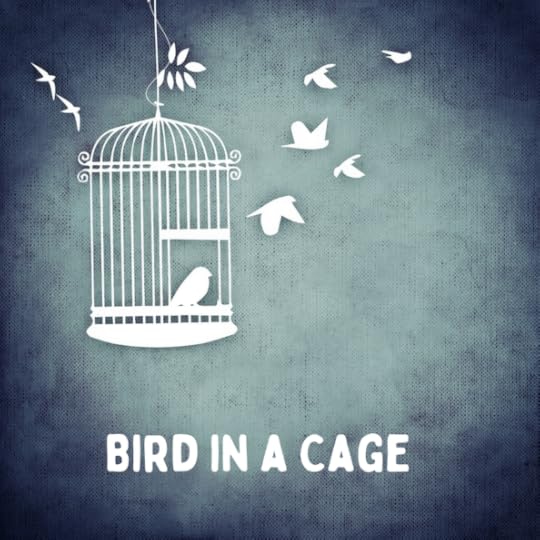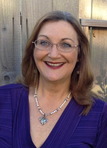Janice Hanna's Blog, page 10
September 1, 2024
Bird in a Cage
For freedom Christ has set us free; stand firm therefore, and do not submit again to a yoke of slavery.
Galatians 5:1 ESV

We all have years in our lives we’d sooner forget. For me, there were two that overlapped—2006 and 2007. Over a span of less than a year I lost my father, my home, my sister, and a dear friend. While attempting to sell our home, a shady broker attempted to steal it out from under us! And, to make matters worse, my oldest daughter developed toxemia in the final week of her pregnancy with my first granddaughter. (Maddy was born healthy, praise God!)
What a crazy season that was!I was nearing the end of my troubles (I thought) when I went to a work meeting. While coming down some stairs, I missed a step and fell.
The doctors called it a catastrophic injury—clean breaks through the tibia and fibula, as well as several breaks in the foot. This fall led to two separate surgeries and several weeks in a wheelchair, because I also sprained several other limbs in the fall. What a fiasco!
I had one important thing working in my favor during that season—a promise of a book contract with a favorite publisher. Imagine my shock and sadness to learn, while still recovering, and in desperate need of finances, that they weren’t going to publish my book after all.
My heart grew bitter and cold.I was angry at the editor. Angry at God. Angry at my loved ones who had died. Angry at myself for not keeping a closer eye on the steps as I descended them. Basically, I was holding everyone in unforgiveness.
A writing buddy sent an email, sharing a dream she’d had about me. In the dream she saw a bird in the cage. Though the door was wide open, the bird refused to come out. I understood the message: I was trapped in the cage of bitterness and unforgiveness.
The day after I received the email a good friend (who knew none of this) gave me a greeting card. On the outside of the card—a tree with a lone bluebird, sitting on the branch, singing his heart out.
I got the message. God wanted to set me free, to fly out of the cage.
He wants to set you free, too. No matter who has wounded you, it’s time to let it go. Forgive. . .and be set free!
Challenging Thought: Is there someone you’re holding in unforgiveness today? If so, do your best to free that person (and yourself) from the cage holding you bound.
Read more devotions like this one in a new book Janice co-authored with Louise Looney titled An Overcoming Walk of Peaks and Valleys, now available on Amazon!
The post Bird in a Cage appeared first on Janice Thompson, Author.
August 31, 2024
Grandma Pearl’s Heavenly Divinity

If you’ve read my book Movers and Shakers (a Guideposts mystery) you already know about Grandma Pearl. She’s a key player in the story, though all of the information about her is shared posthumously.
At the end of the book I shared a recipe that actually came from my own mother’s cookbook. It’s called Grandma Pearl’s Divinity, but it’s really Shirley Ann’s divinity. And I know my mama would be happy to proud to have it shared here, with you.
Grandma Pearl’s divinity is truly heavenly! This is one culinary confection that will leave your guests clamoring for more. Pillowy soft, these little puffs of Christmas magic will send you reeling back in time to the Christmases of yesteryear.
So, what are we waiting for? Let’s take a look at what you’ll need to make this delicious recipe!
Divinity Ingredients: ½ cup Karo corn syrup2 cups sugar½ cup water¼ teaspoon salt2 egg whites1 teaspoon vanilla1 cup chopped nutsHow to Make Grandma Pearl’s DivinityCook the first four ingredients to hard ball stage (260 degrees).
Beat egg whites separately. Slowly pour hot syrup into egg whites.
Continue beating until it holds its shape. Add vanilla and nuts if desired.
Scoop onto wax paper and allow to cool. Store in sealed, airtight container in cool, dark place with wax paper between each layer. (Refrigeration is acceptable but might cause condensation, an enemy of the meringue! Divinity can be frozen in Ziplock bags for up to one year.)
Before you leave, check out Movers and Shakers at ShopGuideposts.org!

If you’re interested in more recipes like this, check out my baking site: Out of the Box Baking!
The post Grandma Pearl’s Heavenly Divinity appeared first on Janice Thompson, Author.
August 28, 2024
Take Heart!
I don’t know what the upcoming days and weeks will look like. I suspect there will be hard times ahead, not just here in America, but across the globe.

I usually get this same sensation before a hurricane blows in, as I prep my house, my supplies, and my heart. I make sure I have everything I need for the days ahead. I check in on my family to make sure they’re ready. I text my friends to ask, “You guys okay?” And I do my best to shift my focus from the incoming storm to the One who controls it all, because I know–hurricanes being so unpredictable–that I can’t put my trust in anything or anyone but Him.
More than anything, I do my best to shift my thinking, from fear to confidence in Jesus. It’s easier these days, because I’ve been walking with Him for so long. I gave my heart to Jesus years ago, and knowing I’m safe in His arms gives me a strange and wonderful peace, even in the middle of the storm. I’ve settled the issue of where I’m going when this life is over, so I don’t have anything to fret, even when darkness closes in around me.
And let’s face it. . .There’s a lot of darkness out there right now.
If you’re reading this and you haven’t yet put your trust in the God who both created and adores you, this is the perfect time to do so! Jesus gave His life for you on the cross, taking on all of your sin and shame, so that you could spend eternity with Him. Ask Him to come into your heart and take the reins of your life. Acknowledge Him as King and Savior. Give Him full control and He will give you peace in the days ahead, as well as discernment to understand the season we’re in–a season where we will need each other more than ever.
And then. . .take heart.Merriam Webster defines “take heart” this way: to gain courage or confidence : to begin to feel better and more hopeful.
Take heart! No matter what the headlines say. Take heart! No matter how high or low your bank balance. Take heart! No matter what physical or psychological challenges you face.
Walk with courage. Walk with confidence. Walk with peace.
It’s all possible when you choose to walk with Him.
“I have told you these things, so that in me you may have peace. In this world you will have trouble. But take heart! I have overcome the world.” (John 16:33)
The post Take Heart! appeared first on Janice Thompson, Author.
August 25, 2024
The Word will Go Forth
But seek first the kingdom of God and his righteousness, and all these things will be added to you.
Matthew 6:33 ESV

Many years ago, I attended a Missions conference where many great men and women of God shared remarkable, inspiring testimonies about their time on the mission field. I was particularly intrigued by a story shared by missionary and pastor Jim Hester.
Jim and his wife were preparing to leave for Russia, where they had planned to smuggle in 25,000 Bibles. Unfortunately, the time of their departure was coming quickly, and they had not raised enough funds to purchase all of the Bibles. Can you imagine? You’ve been entrusted to take the Word of God to people who’ve been tucked away behind the Iron Curtain, and you can’t afford the one thing you need the most?
Each Russian Bible would cost fifty cents, and they were $7,000 short. That’s 14,000 Bibles short!
God Always Has a PlanAround that same time, God spoke to Jim and told him to give a sacrificial offering of $1,000 to a completely different ministry. Jim delayed. He knew that, in the natural, to give away $1,000 would take away from his ability to purchase more Bibles for his upcoming trip.
But God! When God speaks, it’s best to listen, and obey!
Jim finally obeyed the voice of the Lord and gave away the thousand dollars to the other ministry.
Then God did what only He can do. He supernaturally opened a door, and provided 110,000 Russian Bibles absolutely free! Wow! Can you imagine what might have happened if Jim had not listened to the voice of God?
Obedience is always the key to God’s provision.I don’t know where you are, or what you’re facing—financially or otherwise. But I do know that you can’t out-give God, no matter how hard you try. I also know that obedience is key. He speaks. We obey. He blesses. It’s a lovely formula for success! So, open your hands and your heart to be used to bless others. In turn, God will meet your every need.
Challenging Thought:Have you ever witnessed God’s miraculous provision?
The post The Word will Go Forth appeared first on Janice Thompson, Author.
August 24, 2024
Stir up a Hornet’s Nest
No doubt you’ve heard the old adage, “He stirred up a hornet’s nest!” This week I actually lived this out in a very real way.

A few days ago, I spotted large red wasps and hornets buzzing around my backyard. With my dogs—especially my small foster pups—playing outside, I was concerned about the risk of stings. Determined to find the nest, I kept a close watch and soon saw a hornet emerging from my damaged grill, which had been wrecked during Hurricane Beryl. I quickly grabbed a can of wasp spray and prepared to tackle the problem.
Y’all.A horror show awaited me. Angry red hornets came flying out of a nest that was about the size of a small cantaloupe. It all happened so fast. The hornets were massive and so were the white wormy-looking creatures also slithering out of the holes in the nest. I flew into action (pun intended) and did my best to kill as many as I could, ducking and swerving as I went. Thank God I did not get stung. The wasp spray was effective. Most of the hornets died, but a few got away, no doubt happy to live another day.
All’s Well that Ends Well?I dragged the busted grill to the front of the garage so that I would remember to drag it to the curb on big trash day. But one problem remained: There were at least three VERY angry hornets searching for their nest and they made their presence known every single time I stepped outside in the days that followed. They were vicious. They were desperate. In short, they were stirred up. From that point on, I was marked as Enemy Number One and they dive-bombed me every chance they got. I’m still battling them, even as I write this post. The battle might go on for a while, but I won’t give up. I will conquer them.
There’s an implication (going back to the old adage) that you don’t want to be the one who stirs up the hornet’s nest. Just keep the peace. Don’t get worked up. And I get it. We don’t want to be troublemakers.
But, let’s look at this from a different angle.We’re living in a day when the hornets are setting up camp all around us. They build their nests near our homes and they hover, ready to attack—our families, our friends, our beliefs, our churches, our schools. They dart and fly and threaten at every turn. We often walk right by them and pretend they are not there while they secretly grow the nest larger and larger.
Some would say, “Just leave those nests alone. Ignore them. For pity’s sake, don’t stir them up.”
But, folks. SOMEONE has to be brave enough to spray the nest. We might not get them all, but if no one speaks up, if no one calls evil EVIL, then before long the whole yard is infested and we can’t let the kids play outside anymore.
It takes courage to stand up to a culture that contradicts everything the Word of God teaches. But that same Word is far more powerful than any can of wasp spray. We can use it to take down strongholds and protect our homes, our families, and our hearts.
Sure, we’ll still have a few angry pests to battle on the daily once we make our presence known. But it will be worth it in the end, to get rid of the infestation. The kids will be safe to play in the yard again. And we can go to our graves, knowing that we took a stand for what was right. We can stand before God and say, “I gave it my best shot.”
All that to say…I’m planning to stir up a few hornets’ nests while I’m here on the planet. I hope you will join me. And may the world be better off for it.
“For though we live in the world, we do not wage war as the world does. The weapons we fight with are not the weapons of the world. On the contrary, they have divine power to demolish strongholds. We demolish arguments and every pretension that sets itself up against the knowledge of God, and we take captive every thought to make it obedient to Christ.” – 2 Cor 10:3-5
The post Stir up a Hornet’s Nest appeared first on Janice Thompson, Author.
August 23, 2024
Bessie Mae’s Dewberry Cobbler
Welcome to Saturday baking day, where I post recipes from my novels. This is my first recipe post and I’ve started with a personal favorite!

If you’ve read Tracking Tilly, my latest cozy mystery from Barbour Publishing, you are familiar with Aunt Bessie Mae. She’s an amazing older gal–the matriarch of the Hadley family. She’s also an amazing cook!
Bessie Mae is particularly good at making cobbler. I don’t know about you, but I’m crazy about cobbler, myself. If you follow my baking blog (Out of the Box Baking) no doubt you’ve already figured that out.
I have a terrific recipe for cobbler, which is just like Bessie Mae’s. So, I’m happy to share that here. And if you’re in the mood to check out more of my recipes at my baking blog, feel free!
Dewberry Cobbler IngredientsHow to Make this Dewberry Cobbler
FOR THE BERRY MIXTURE:1 pound frozen dewberries or blackberries3/4 cup granulated sugar3 tablespoons cornstarch1/4 cup water (more or less)2 tablespoons lemon juice1 teaspoon lemon zest (optional)FOR THE CRUST:1 cup all purpose flourpinch salt1/2 cup Crisco1/8 cup cold wateregg (for wash)sugar (to sprinkle)
I’ve already shared the particulars on that over on my baking blog, so follow this link to read the post or check out the image below from the book.
If you make Bessie Mae’s cobbler, feel free to share in the comments. I’d love to get your thoughts!

I promise, you’re going to love this delicious recipe. And if you’re in a hurry, you can use store-bought pie crust. (Shh! I won’t tell Bessie Mae, I promise!)
Speaking of Bessie Mae. . .
Enjoy this blurb from Tracking Tilly.
As we wrapped up the second round of dumplings, Bessie Mae pushed back her chair and attempted to stand. Poor dear was having a harder time lately getting around. Mason must’ve noticed. He sprang from his seat and helped her up.
“Well, thank you kindly.” She flashed him a warm smile. “And for that you’ll get a double portion of my dewberry cobbler once I get it whipped up.”
“Dewberry cobbler?” He rested his hand on his stomach. “Are you serious?”
“Well, sure. It’s dewberry season, and RaeLyn picked buckets of ’em last week. Our freezers are about to pop with berries. It won’t take me more than a few minutes to fashion up a cobbler, so I hope you’re not in a hurry. Would’ve done it sooner, but my back was giving me fits today.” She rested her hand on her side. “I’m at the age where my back goes out more than I do.” A little chuckle followed. “Now, am I gonna have to wash these berries all by myself, or are you two gonna get over here and help me?”
I guess that was an order to help. I rose and made my way toward them.
“Would you pass me that bowl of dewberries from the fridge, RaeLyn?” My aunt’s eyes twinkled as she offered instruction. “Let’s get this show on the road.”
I reached into the refrigerator for the huge bowl of fresh dewberries and set it on the counter next to her, then watched as she transferred them into a colander, which she placed in the sink. Moments later, the water was running over them.
Mason stuck his hand in the bowl and popped a juicy berry into his mouth. A look of delirium came over him. “How many times did we go dewberry picking together when we were kids, RaeLyn? A thousand?”
“At least.”
“Remember how we used to sneak onto the Jackson property to pick berries in the far back corner, just past that dilapidated old shed? They were the best in the county.”
“You stole berries from Wyatt Jackson?” Mom’s brows arched. “Don’t tell me that’s where you got these.
“Nope. These are all from our own property. Haven’t been to Wyatt’s place in years. And even then, it was on the far edge of his property, right alongside the field next to him.”
“Sure wouldn’t recommend trespassing over there these days,” Bessie Mae said. “He’d probably come after you with a shotgun.”
“No one ever picked his dewberries but us, so they would’ve just rotted on the vine.” I shrugged. “But they’re not worth dying over, so I won’t be going back. No need to worry.”
Enjoy the recipe and the book! Get your copy of Tracking Tilly at Amazon today!

The post Bessie Mae’s Dewberry Cobbler appeared first on Janice Thompson, Author.
Just Enough, and Just in Time
And my God will supply every need of yours according to his riches in glory in Christ Jesus.
Philippians 4:19 ESV

When you’re young, the world is your oyster. All you see are sunny skies ahead. And even after marrying, you’re convinced it’s going to be a breeze because you have each other.
Unfortunately, most young couples go through unexpected struggles, and many face financial hardships. Such was the case when I was a young wife and mother. We had our daughters very quickly after marrying and finances were always tight, especially after our third daughter was born with health issues.
Things Got Rough…One particular month we got behind on our mortgage. It wasn’t a ton of money (just $300) but in the 80s that seemed huge to a young, struggling family.
On a particular Wednesday night I went to church, burdened down with the weight of this problem. If I didn’t come up with $300—and soon—the mortgage company might take action against us.
I walked the kids back to their classrooms and, as I made my way back to the sanctuary, a friend met me in the hallway. She handed me a plain white envelope with nothing written on it.
“What’s this?” I asked.She shrugged. “It’s the strangest thing. Just now, a man in the sanctuary passed this to me and told me to give it to you. He said that God woke him up this morning, put your face in front of him, and said, “Give this woman $300.”
“W-what?” I couldn’t believe my ears. I opened the envelope and, sure enough, found three crisp one-hundred-dollar bills inside. I gazed at my friend, dumbfounded. “What man? Who is he?”
She shook her head and smiled. “Nope. Can’t tell you. He said not to.” And then she turned and headed off down the hallway.
It’s been nearly forty years since that remarkable evening, but I’ve never forgotten that God gave me just what I needed, and just in time! What a lesson I learned about placing my trust in Him.
He will do the same for you, you know. He might not awaken a stranger to take care of your needs, but He sees and He is already making provision. So, place your trust in Him today. Out of an abundance of love, He’s covering you completely.
Challenging Thought:Do you trust God to provide, even when the cupboard is bare?
Read more devotions like this one in a new book Janice co-authored with Louise Looney titled An Overcoming Walk of Peaks and Valleys, now available on Amazon!
The post Just Enough, and Just in Time appeared first on Janice Thompson, Author.
August 22, 2024
Take Heart

I don’t know what the upcoming days and weeks will look like. I suspect there will be hard times ahead, not just here in America, but across the globe.
I usually get this same sensation before a hurricane blows in, as I prep my house, my supplies, and my heart. I make sure I have everything I need for the days ahead. I check in on my family to make sure they’re ready. I text my friends to ask, “You guys okay?”
And I do my best to shift my focus from the incoming storm to the One who controls it all, because I know–hurricanes being so unpredictable–that I can’t put my trust in anything or anyone but Him.
We Can Trust Him, No Matter WhatMore than anything, I do my best to shift my thinking, from fear to confidence in Jesus. It’s easier these days, because I’ve been walking with Him for so long. I gave my heart to Jesus years ago, and knowing I’m safe in His arms gives me a strange and wonderful peace, even in the middle of the storm. I’ve settled the issue of where I’m going when this life is over, so I don’t have anything to fret, even when darkness closes in around me.
And let’s face it–there’s a lot of darkness out there right now.
If you’re reading this and you haven’t yet put your trust in the God who both created and adores you, this is the perfect time to do so! Jesus gave His life for you on the cross, taking on all of your sin and shame, so that you could spend eternity with Him.
Ask Him to come into your heart and take the reins of your life. Acknowledge Him as King and Savior. Give Him full control and He will give you peace in the days ahead, as well as discernment to understand the season we’re in–a season where we will need each other more than ever.
And then. . .take heart.
Merriam Webster defines “take heart” this way: to gain courage or confidence : to begin to feel better and more hopeful.
Take heart! No matter what the headlines say.
Take heart! No matter how high or low your bank balance.
Take heart! No matter what physical or psychological challenges you face.
Walk with courage. Walk with confidence. Walk with peace.
It’s all possible when you choose to walk with Him.
“I have told you these things, so that in me you may have peace. In this world you will have trouble. But take heart! I have overcome the world.” (John 16:33)
The post Take Heart appeared first on Janice Thompson, Author.
August 17, 2024
Introducing: Tracking Tilly
TEXAS AUTHOR SETS FAITH-BASED NOVEL IN MABANK AREA

Spring, Texas, August 17th, 2024. Award-winning Christian author Janice Thompson has tapped into her love of all-things-Texas in her latest cozy mystery series from Barbour Publishing. Book One in The Little Red Truck series is titled Tracking Tilly. This fun cozy mystery, set in the Cedar Creek Lake area, has just released and is already garnering great reviews!
SYNOPSIS: The Hadley family ranch is struggling, so RaeLyn, her parents, and brothers decide to turn the old barn into an antique store. The only thing missing to go with the marketing of the store is Grandpa’s old red truck, Tilly, that was sold several years ago. Now coming back up on the auction block, Tilly would need a lot of work, but RaeLyn is sure it will be worth it—if only she can beat out other bidders and find out who stole Tilly after the auction ends. Hadley finds herself in the role of amateur sleuth, and the outcome could make or break the new family venture.
ABOUT THE SETTING: Thompson set the story in the Mabank area to honor her mother and step-father, Shirley and Billie Moseley, who lived in nearby Eustace. They were faithful members of 1st Baptist Church, Mabank. Janice’s memories of the area are warm and cozy, just like this fun story!
According to reviewer Anne W, “This was a heartwarming story of family and friends, who had their own issues and lives, and yet they reached out to help with the search for Tilly, and to prepare the barn for the grand opening of the antique store. There is a large cast of characters in this delightful, sweet story. They are relatable and not easily forgotten.”
The story is a work of fiction but draws from the beautiful surroundings of the Cedar Creek Lake area. To pick up your copy of TRACKING TILLY, visit Amazon.com, Barnes and Noble, or Christianbook.com.

Award-winning author Janice Thompson got her start in the industry writing screenplays and musical comedies for the stage.
Janice has published over 160 books for the Christian market, crossing genre lines to write cozy mysteries, historicals, romances, nonfiction books, devotionals, children’s books and more.
She particularly enjoys writing light-hearted, comedic tales because she enjoys making readers laugh. Janice is the owner of Out of the Box Baking blog, where she shares recipes and baking tips.
###
The post Introducing: Tracking Tilly appeared first on Janice Thompson, Author.
FOR IMMEDIATE RELEASE
TEXAS AUTHOR SETS FAITH-BASED NOVEL IN MABANK AREA

Spring, Texas, August 17th, 2024. Award-winning Christian author Janice Thompson has tapped into her love of all-things-Texas in her latest cozy mystery series from Barbour Publishing. Book One in The Little Red Truck series is titled Tracking Tilly. This fun cozy mystery, set in the Cedar Creek Lake area, has just released and is already garnering great reviews!
SYNOPSIS: The Hadley family ranch is struggling, so RaeLyn, her parents, and brothers decide to turn the old barn into an antique store. The only thing missing to go with the marketing of the store is Grandpa’s old red truck, Tilly, that was sold several years ago. Now coming back up on the auction block, Tilly would need a lot of work, but RaeLyn is sure it will be worth it—if only she can beat out other bidders and find out who stole Tilly after the auction ends. Hadley finds herself in the role of amateur sleuth, and the outcome could make or break the new family venture.
ABOUT THE SETTING: Thompson set the story in the Mabank area to honor her mother and step-father, Shirley and Billie Moseley, who lived in nearby Eustace. They were faithful members of 1st Baptist Church, Mabank. Janice’s memories of the area are warm and cozy, just like this fun story!
According to reviewer Anne W, “This was a heartwarming story of family and friends, who had their own issues and lives, and yet they reached out to help with the search for Tilly, and to prepare the barn for the grand opening of the antique store. There is a large cast of characters in this delightful, sweet story. They are relatable and not easily forgotten.”
The story is a work of fiction but draws from the beautiful surroundings of the Cedar Creek Lake area. To pick up your copy of TRACKING TILLY, visit Amazon.com, Barnes and Noble, or Christianbook.com.

Award-winning author Janice Thompson got her start in the industry writing screenplays and musical comedies for the stage.
Janice has published over 160 books for the Christian market, crossing genre lines to write cozy mysteries, historicals, romances, nonfiction books, devotionals, children’s books and more.
She particularly enjoys writing light-hearted, comedic tales because she enjoys making readers laugh. Janice is the owner of Out of the Box Baking blog, where she shares recipes and baking tips.
###
The post FOR IMMEDIATE RELEASE appeared first on Janice Thompson, Author.
Janice Hanna's Blog
- Janice Hanna's profile
- 75 followers



